As a Wyoming-native, outdoor enthusiast, and certified idiot, I’ve had many too-close wildlife encounters. There was only one occasion that even an idiot like me couldn’t help fearing for her life. But just because I’ve been far too close to big, scary wildlife more often than your average Joe doesn’t mean I’m looking for opportunities to add to the tally.
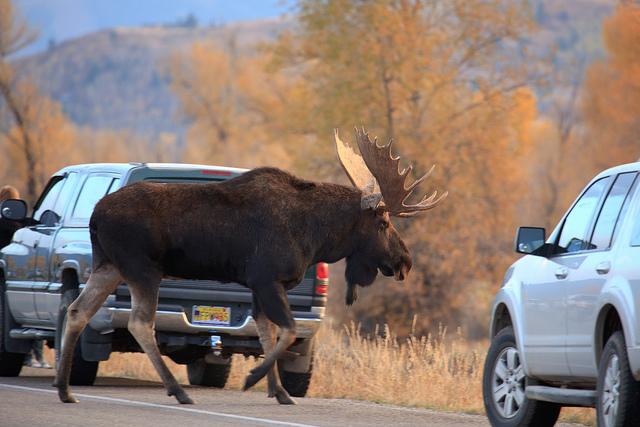
You only have to be charged by one of these guys once to know you never want to do it again. Or I guess “never” probably works for anyone who isn’t an idiot like me. photo: daniel d’auria
Alaska is full of opportunities for foolhardy wildlife encounters, especially for idiots loathe to relinquish their naiveté. Do I want to come face to face with a bear, wolf, or moose? No. Am I going to relentlessly employ annoying prevention tactics? Ummm… some? Yes. 100%? Unlikely. They probably don’t make much of a difference anyway, right? They’re probably a silly waste of effort and one’s vocal chords, right?
An Idiot Costs Others
The more brushes I have with death, the more I realize how incredibly rude and selfish it is to be cavalier. Not only have I risked my own life on many handfuls of occasions, but also those of several friends. In the height of my idiocy I failed to acknowledge how my choices would affect:
- the people I’d cajoled into joining my adventures
- my friends and family (no more sister, daughter, aunt, granddaughter, confidant)
- the lives of search and rescue workers and potentially their families and communities
- the lives of the majestic animals who would theoretically knock me a level down the food chain
- the experiences of thousands of people who would lose the opportunity to see said animal themselves
- potentially an entire species (as these animals are often endangered).
(Just in case this is too vague for you, the order of events after an animal attacks a human is generally “removal.” E.g. it gets hunted down and killed to prevent further attacks on humans. That’s one less majestic animal for others to see, one less species member.)

Hey guys. Sorry about my selfish obsession with my personal adventure that ends in you risking your lives to get me back to civilization…
Fast Forward to Alaska 2017
I’d love to claim I’ve done a 180 in the safety department. The truth is closer to the old axiom about taking the girl out of the country, but not being able to take the country out of the girl. I absolutely take safety 1,000 times more seriously than in the past. Trouble is, I was so unsafe before that the improvement doesn’t exactly land me in pocket-protector territory.
In the lead up to a Denali backpacking trip, I actually prepared. I hiked. One of my trip buddies and I actually got together and practiced map and compass skills. I actually packed a full set of anti-hypothermia gear and instant-heat packs. I re-educated myself about trenchfoot when the forecast called for 100% rain. I even bought hiking boots, despite being a barefoot/sandals hiker for years.
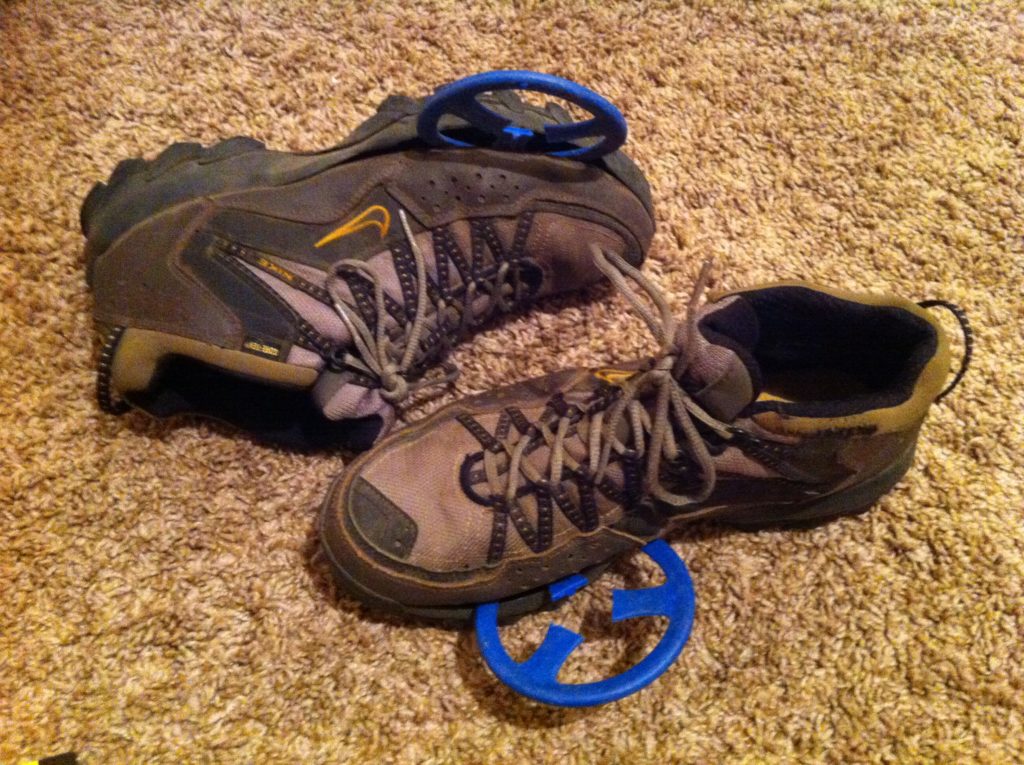
I didn’t say I got “good” hiking boots. I was so certain I wouldn’t end up wearing them, I bought second hand boots that fell apart on a test hike. The second glue job at 3 a.m. the night before held. But I only wore the boots for about an hour of the entire (dry!) trip, preferring my Lems (which rocked).
Yes, our first night camp was in a location with good visibility, despite the wind. Yes, our bear-proof food canisters were stored 100+ yards from that. Yes, our camp kitchen was 100 yards from either of the latter. However, I remarked as we descended to the sheltered creek (all the more convenient to cook by, my dear!) that even the waterside kitchen area with the most visibility still didn’t afford us much of a view. In all honesty, we were at the bottom of a funnel with good visibility in only one direction. But… it will probably be fine.
As we cooked our evening meal, we did the requisite shouting to prevent surprise encounters with any animals who might be upwind of us. In the morning, we were slightly less vigilant as we proceeded through the most leisurely packing session I’ve ever participated in. Finally all three of us were ready. We shouldered our heavy packs and headed up out of the river drainage. The two people carrying bear spray led the charge, followed by your trusty idiot. I glanced back toward camp and couldn’t believe my eyes. My head whipped back around to evaluate what was now my path of escape. I struggled for the appropriate words to alert my companions regarding the giant grizzly mama and her yearling cubs just three car lengths away from us.
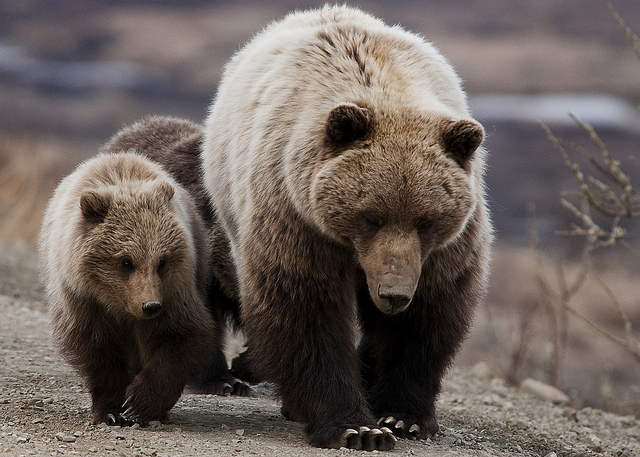
Uh oh. photo: tim rains
I’d thought through bear encounters multiple times in the lead up to the trip. (The fact that my brain loves analytical observation and theoretical logistics is probably the only reason I’ve lived through so many poor choices.) My primary concern in all my imagined scenarios was poor reactions from my companions. If their primal instincts were to run, and if those instincts took over, we’d all be screwed. 1I’m not saying I have any doubts as to these ladies’ abilities to keep it together. Given my previous experiences encountering land-dwelling predators at very close range, I knew myself to be capable of holding my ground. However, when I taught myself shark attack prevention and shark fighting tactics while living in Australia, I expected my calm on land to transfer to the water. But the first time I genuinely thought there was a shark right next to me in the water? I unthinkingly covered more than 90% of the distance to shore at breakneck swimming speed… exactly what you’re not supposed to do. One cannot necessarily control one’s primal instincts. So when I had to announce the presence of death-causing animals to my trail buddies, I did so with the primary objective of making damn sure they wouldn’t freak out.
“Okay guys, everything is fine but there’s a mama and her cubs just to our left. Go ahead and keep walking. She’s watching us, but not coming toward us. We’re going to keep moving up and out of here. You can glance back and have a look if you want. She’s still just watching us. Keep moving steadily forward. Go head and take your bear spray off your belt and take the safety clip off. We probably won’t use it, we’re just getting ready. Keep traveling up, but stay off the scree. It’s better for us to be on good footing and gain our distance there…” …blah blah blah.
To our enormous relief, the mama watched us but stayed with her cubs while they continued their riverside foraging. We crossed our fingers they’d keep traveling the path of least resistance – downhill – as we traveled up to Tattler Creek’s headwaters.
So Many Bears
A few days later, we followed our first-day shuttle driver’s advice to come out of the backcountry and hitch a bus up to his favorite park spot several hours down the road. A few minutes after boarding the bus, we saw another mama and cubs (babies, not the yearlings of the day before). Much, much nicer seeing them from the bus window!
At the Toklat Visitor’s center, I wandered in to check things out. Standing in the corner was a giant, taxidermy grizzly up on his hind legs. The sign at the bottom explained how the bear met his demise… in the exact same two-mile-long drainage (Tattler Creek!) where we’d had our bear encounter. Really?
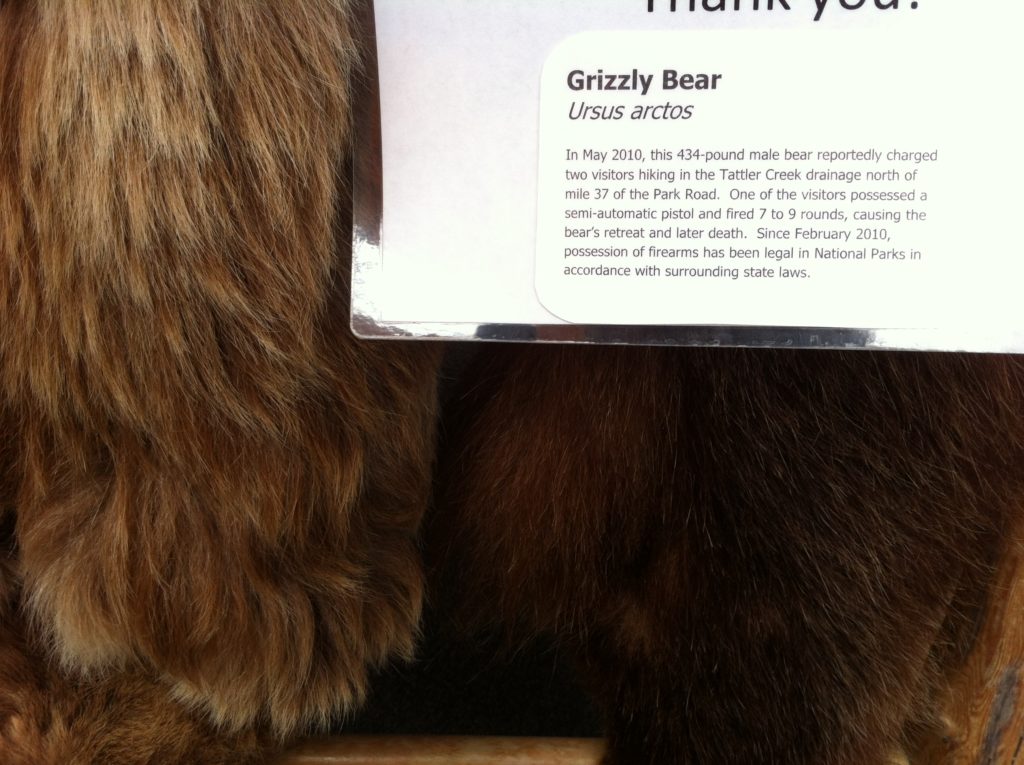
Um… is there something someone’s not telling us about Tattler Creek?
Throughout the day, as we talked bears with park staff we encountered, we discovered there was a mama bear with two yearling cubs who were quickly earning the label of problem bears. After a series of incidents, including the aggressive and insistent investigation of a school bus on which a ranger was taking a nap the day before, the park took action. In anticipation of further problems that may require time-sensitive responses, they stationed a ranger in a generally vacant building near the epicenter of encounters.
Sleeping in The Bear Epicenter – Unit 29
The epicenter was at the bottom, right-hand side of the backcountry map covering the area for which our overnight permit was valid. When we bought the map and copied the required boundary lines and animal closures onto it, we didn’t think much of it. For months we’d been preparing ourselves for the intense Denali process where you only find out where you’ll be hiking anywhere from just a day to just 90 minutes (like us!) before you actually hit the trail. We knew the drill:
- go to backcountry ranger station
- watch an hour of videos
- look at availability of backcountry units
- think through theoretical trips in each unit
- pick one & fill out paperwork to claim it
- buy map and copy unit boundaries and animal closures onto it
- listen to an individual ranger safety talk
- listen to a group ranger safety talk
- obtain bus tickets
- ride one of four daily hiker buses a few hours to your entry point
We weren’t at all surprised to see wildlife closures throughout the park. We thought nothing of it when copying the closures flanking the road side of Unit 29 onto the map. No worries. All you have to do is not go in those areas. The rangers we’d talked with before choosing our unit said nothing about the closures either. They certainly didn’t tell us the closures were permanent. Say what?!
At our final visitor’s center of the day, I would discover those areas have been closed to humans since the 1950’s because of the frequency of wildlife presence. That’s right. They are still closed as you read.
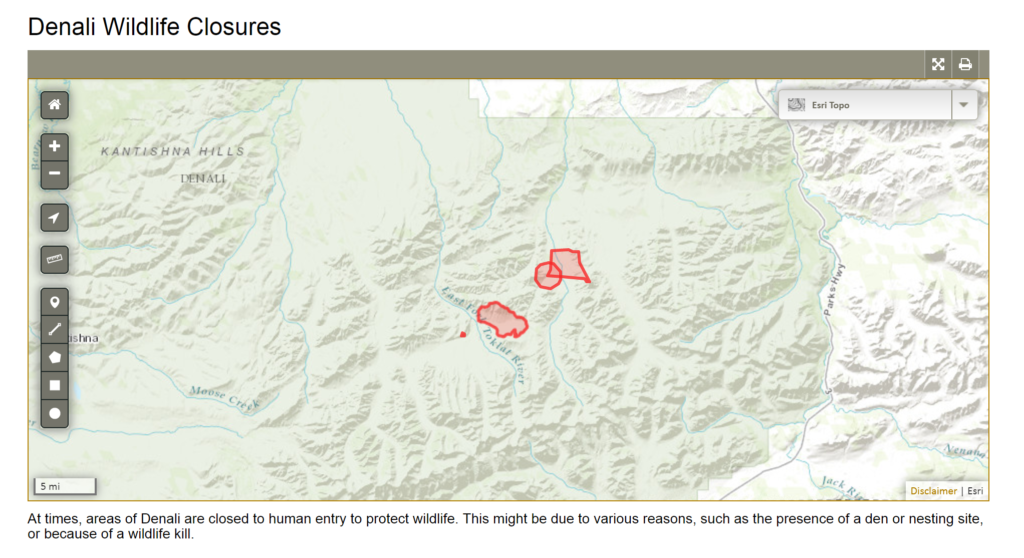
A screenshot of the current 2017 closures… all but the left-most dot and the right-most square-ish shape are supposedly permanent or have been closed for years.
While writing this, I discovered marketing departments tout these closures to their Denali-bound guests as an almost guarantee of bear sightings. I’m not sure if we’d have made a different choice if the rangers had actually alerted us, but I’m pretty sure I wouldn’t necessarily return to Unit 29 in Denali again.
The Bear Count Climbs
On our final morning, as we broke camp, our worst nightmare came true. Well not worst. Second worst. Worst would be another face-to-face bear encounter or attack. Second worst: on the other side of the valley at a very, very safe distance we spotted a mama and cubs. They were so far away that watching them through the binoculars was a joy.
However, at the bottom of the valley between us ran the park road. That meant we’d have to halve the distance between us and the bears to get out of the park. And we were on a timeline. My Seattle-based bestie had to be back in Anchorage for her flight with only 90 minutes of wiggle room in the day.
Even worse: the bears matched the description of the trouble bears we’d heard about the day before. To leave the park, we had to travel directly toward the aforementioned epicenter. And we were already close enough to it for these bears to be the problem bears… i.e. the bears that would not shy away from checking us out.
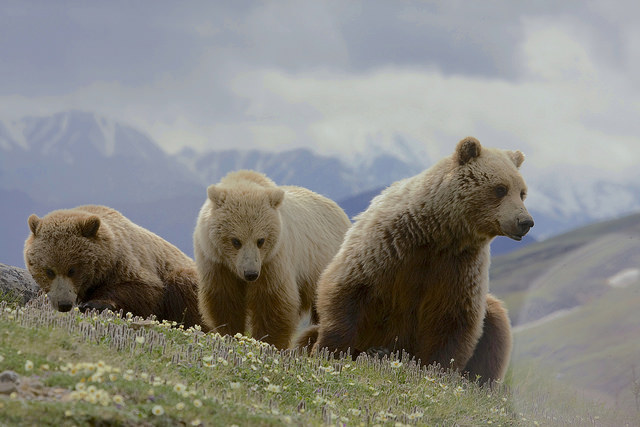
“Hey kids, Mom sees some interesting possible food sources and playthings. Shall we go quickly down this hill and have a little chat with those three hiker ladies?” photo: gregory “slobirdr” smith
Worse still: once we departed, we’d no longer be able to see the bears. We would beeline to the park road not knowing if the bears were headed toward us. The park road was downhill from the bears. And let me ask you a question… given a choice to walk up a hill or down it while foraging for berries, which would you choose?
With tensions running high, we dropped quickly down a steep drainage with a plan to flag the first bus that came along and insist they let us on. (The day before, when we’d hiked out and ventured further into the park, we were turned down by the first handful of buses because there were no seats.)
At the road, we fidgeted nervously, straining to hear any sounds of engines in the distance while staring frequently in the last known direction of the bears. Our outbound park bus wasn’t due for another 30 minutes, so we decided to hop the first inbound bus possible. Finally one rolled over the horizon. As the gap between us and safety closed, it felt like the bus couldn’t go any slower. And then, when it was about 100 yards away, the bus stopped. And so do did the three buses behind it.
We were now a bus/bear sandwich. And given the buses only stop en masse for wildlife sightings, we were now very possibly in the middle of a bear-bear sandwich. Just standing there completely exposed with zero defenses or shelter possibilities.
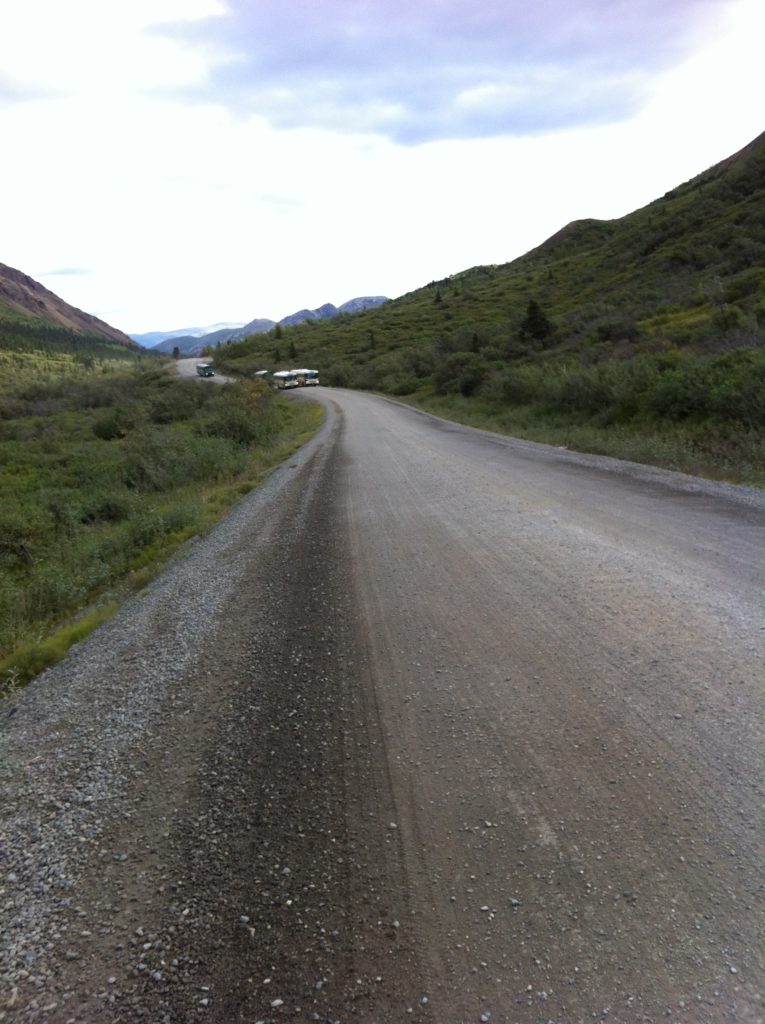
Buses to our left, known bears to our right, and we’re… stuck in the middle with you nowhere to hide or run.
It’s a testament to our levels of adrenaline that I can’t even remember finding out if the buses had been stopped for bears or not. We rushed through an explanation to the driver and staring passengers as we made our way to the backpack-holding-area at the back of the bus. They were all pleased to hear us announce there were probably bears just around the next corner. Our hearts were still pounding when the bus rounded the bend and ground to a halt at the sight of our mama and cubs right next to the road. Yikes!
It Ain’t Over Yet
Next problem: getting on the first outbound bus of the day, which was also the only bus that leaves the park in time to get my Seattle-bestie to the airport on time.
We asked the driver if he could just flag down the outbound bus so we could hot-seat, but he said he might not recognize it. Staying on our bear-rescue bus meant possibly missing our ride out of the park. But getting off our bear-rescue bus meant pitching ourselves right back into bear territory. Tough call. As we approached our original entry point, technically outside (but right between) the wildlife closures, just under a mile from our first bear encounter, and about a mile from our bear sighting a few minutes before, we took the final risk of the trip.
We piled off the bus, hearts pounding again, silently begging the outbound bus to appear as we warily eyed the bushes. The same bushes from which we know a mama and cubs emerged a few days before, shortly after not-attacking us.
Relief flooded our veins as the outbound bus came into view. We climbed aboard and relished spending our last hours in Denali inside the safety of antiquated, green steel walls. It was probably the last trip of my life in Unit 29, and I can’t say I’m sad about that.
Happy Travels! ♣
Related:
The Truth About Alaska
Why You Should Let Frogs Go
My 7+ Near-Death Experiences
References
| ↑1 | I’m not saying I have any doubts as to these ladies’ abilities to keep it together. Given my previous experiences encountering land-dwelling predators at very close range, I knew myself to be capable of holding my ground. However, when I taught myself shark attack prevention and shark fighting tactics while living in Australia, I expected my calm on land to transfer to the water. But the first time I genuinely thought there was a shark right next to me in the water? I unthinkingly covered more than 90% of the distance to shore at breakneck swimming speed… exactly what you’re not supposed to do. One cannot necessarily control one’s primal instincts. |
|---|




Twitter Facebook Google+ StumbleUpon Reddit Pinterest